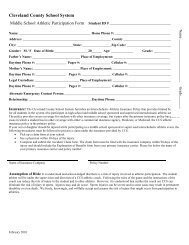Good Ideas for Promoting Character Education by Enhancing ...
Good Ideas for Promoting Character Education by Enhancing ...
Good Ideas for Promoting Character Education by Enhancing ...
Create successful ePaper yourself
Turn your PDF publications into a flip-book with our unique Google optimized e-Paper software.
<strong>Good</strong> <strong>Ideas</strong> <strong>for</strong> <strong>Promoting</strong> <strong>Character</strong> <strong>Education</strong> <strong>by</strong><strong>Enhancing</strong> School ClimateFor character education to be a meaningful program, it must be in evidence andreflected through the entire climate of each school. By creating a school climatethat builds positive relationships among the stakeholders in the school community– administrators, teachers, staff, students, parents, community and faith partners -positive participation is enhanced and disruptive, violent and self-destructivebehaviors are reduced.Features of the school environment directly influence school climate. Thesefeatures include:• School structure and policies• Academic expectations• Behavior expectations• Teacher qualifications and attitudes• Administrative support and leadership• Level of parental and community involvement• Level of student involvement in extra-curriculum activitiesA positive school climate is one that:• Provides clear and consistent expectations <strong>for</strong> student behavior• Encourages students to set high, yet attainable, academic goals.• Responds to discipline infractions <strong>by</strong> providing a range of in-schoolalternatives <strong>for</strong> students to learn appropriate behavior• Models and imparts sound societal values, beliefs, and attitudes• Offers personalized assessment and support <strong>for</strong> students who experienceacademic and/or behavioral problems• Coordinates support and referral services <strong>for</strong> students and their families• Expects and provides meaningful opportunities <strong>for</strong> parental involvement instudents’ education“Many teachers and administrators report that <strong>Character</strong> <strong>Education</strong> activities havespurred significant parental involvement in school life. Rein<strong>for</strong>cing these activitiesand lessons at home is crucial, and a concerted ef<strong>for</strong>t should be made to bringparents into the fold. Do this <strong>by</strong> speaking to them individually about yourapproach and <strong>by</strong> inviting all parents to regular programs coordinated <strong>by</strong> studentsand teachers. Also, be sure to solicit parental participation in all character related
after-school activities”(from <strong>Good</strong> <strong>Ideas</strong> to Help Young People Develop <strong>Good</strong><strong>Character</strong>).What follows is a list of activities, initiatives, and resources that can build aninviting school climate. These ideas focus on proactive ef<strong>for</strong>ts to shape behaviorin productive ways as opposed to reactive responses to disruptive behaviors.While both approaches are necessarily a part of maintaining a safe and secureschool environment, most schools need to expand their ef<strong>for</strong>ts to build a schoolclimate that promotes and recognizes positive behaviors.Ž <strong>Character</strong> Trait of the Month: Encourage the coordinated emphasis of acommon monthly character trait. The school district or individual schoolscan also develop a list of heroes selected <strong>for</strong> their association with specifictraits. These heroes can be historical or current political, religious, artistic,intellectual, or sports figures. Their names and pictures appear onclassroom bulletin boards and teachers refer to them whenever possible indiscussion or writing assignments.Ž Morning Announcements: Share daily message (over intercom, <strong>for</strong>instance) about good character with the whole group. Include a “thought<strong>for</strong> the day” related to the month’s character trait. Encourage students tocreate thoughts <strong>for</strong> the day and select some to be read during morningannouncements.Ž Mottos/Slogans: Have young people write and display “soundbites” and“catch phrases” based on the character trait <strong>for</strong> each month.Ž Quotations of the Week: Display a character related quote on the school’smarquee. Include quotes from famous people, faculty, and students. Havestudents practice writing and using higher order thinking skills <strong>by</strong> usingcharacter related quotes as writing prompts. Publish lunch menus withcharacter quotes.Ž Student Newspaper: Help young people create articles <strong>for</strong> a publication ora publication focusing on ethical living and “local heroes,” includingstudent commentary, reporting, photography and artwork.Ž Library Exhibits and Book Lists: Create wall decorations about bookswhich promote good character and develop a list of recommended readings
which teach good character. Change these monthly to reflect specificcharacter traits.Ž Posters: Give the hallway, cafeteria and gymnasium walls some character<strong>by</strong> displaying banners, slogans, and quotes related to character traits in allareas of the school.Ž Hallway of <strong>Character</strong>: Line the hallway walls with newsprint or butcherpaper and have the students cover them with character slogans or famousquotes about the character trait.• Put up a “Great Wall of <strong>Character</strong>” to display quotes, recognizestudents, and display other character-related reminders.Ž Codes and Rules of Conduct: Design rules based on the character traits<strong>for</strong> adults and young people.Ž Special Events:• Have a yearbook feature or page that focuses on character traits.• Hold theme days (e.g. encourage wearing red, white, and blue on“Citizenship Day”)• Focus graduation and end-of-year ceremonies on character.Ž Art/Creative Projects:• Have a student write and produce plays emphasizing the traits <strong>for</strong> eachmonth (these can draw good publicity-even TV coverage!)• Have students create a character “quilt” out of paper.• Have students create a “Chain of kindness” – a paper chain with actsof kindness written on each link.• Have art classes paint character quotes on the walls.• Hold a poster contest <strong>for</strong> posters to be displayed in homerooms.• Sponsor an essay contest on the importance of character traits.• Sponsor a contest in which students write and per<strong>for</strong>m songs based onthe character traits.Ž Pledges: Design and circulate pledges to “practice the character traits.”Ž <strong>Character</strong> Assemblies: Have guests address the character trait of themonth.
Ž Contests with Awards and Prizes: Submit and recognize essays, art,music, poetry, speeches, plays, etc. related to character traits.Ž Ceremonies and Rituals: Recognize young people annually who modelthe character traits. (Big Brothers and Sisters of Tarrant County, Texas, <strong>for</strong>instance, recognizes its local “SMOREs,” “Students Who ModelOutstanding Responsibility and Ethics,” and calls a press conference topublicize the event.) Recognize good character award recipients at end-ofyearceremonies.Ž Honor Roll (nonacademic): Honor those who honor others with thekindness and goodwill. Institute a “Random Acts of Kindness” programthat gives awards <strong>for</strong> good acts. Send home cards of praise to recognizestudents who demonstrate good character.Ž “Recognition Wall <strong>for</strong> Student Achievement in <strong>Character</strong>”:Periodically have youngsters nominate their peers using criteria based oncharacter traits. Frame and retain the photos on a special wall designated<strong>for</strong> this purpose.Ž Cafeteria “Table Tents”: Have the youngsters design small folded-cardswith character related quotes, ethical dilemmas, or other messages. Placethese on cafeteria tables and encourage everyone to discuss them atlunchtime.Ž <strong>Character</strong> Clubs: Design clubs – one <strong>for</strong> each character trait – and havethe youngsters rotate club affiliation every week or two.Ž Faculty/Staff Training and Discussion: Incorporate the character traitsinto the training of youth leaders and teachers. Provide a list of “examplesof how to be an example.”Ž Including Parents• Hold parent meetings/workshops and designate a group of parents,teachers, and/or other youth leaders to design and administer <strong>Character</strong><strong>Education</strong>.• Send home an in<strong>for</strong>mational packet on the premises and expectationsof the character program.
• At the beginning of the year, have both parents and students sign apledge to build character• Devote an entire parent-teacher organization meeting to the characterdevelopment program.• Discuss character as well as academics in parent-teacher conferences,• Send teacher letters home to parents monthly.• Send newsletters on the character education program home to parents.Ž Parent Meeting/Workshops: Designate a group of parents and teachersand/or other youth leaders to design and administer <strong>Character</strong> <strong>Education</strong>activities.Ž Student/Faculty Task Force: Have students work in coordination withteachers to design, administer and carry out <strong>Character</strong> <strong>Education</strong> activities.Ž Advisors/Advisee Program: Teacher advisors meet with “homerooms” ofstudents and stay with a group throughout their career at the school.Advisors encourage good attendance, participation in extra curriculumactivities, and make contact with parents.A range of service learning activities and projects can positively contribute toenhancing opportunities <strong>for</strong> students to model good character. These include:Ž Peer Helping/Mentoring: Train young people with leadership skills toserve as peer helpers and mentors. Incorporate <strong>Character</strong> <strong>Education</strong> intotheir training.Ž Cross-age Tutoring/Mentoring: Arrange <strong>for</strong> preteens and teenagers tosupport and tutor younger children.Ž Public Area Beautification: Have young people organize and carry out acleanup of a playground, park or other neglected area.Ž Landscaping and Gardening Project: Emphasize taking responsibility<strong>for</strong> one’s own school or youth facility <strong>by</strong> having young people plant andmaintain a garden. Cultivating a community vegetable or flower garden is agreat way to teach many of the <strong>Character</strong> Traits.
Ž Clothing and Food Drives: Collect items of clothing and food and donatethem to an appropriate agency.Ž Meals on Wheels: Bring food to people who are homebound.Ž Caring <strong>for</strong> the Homeless: Organize groups of young people to serve foodat a homeless shelter.Ž Charity Service: Participate as a group in a charitable cause (such as awalk-a-thon) or hold a fundraiser (such as an auction, bake sale, or carwash) and donate the money to a charitable organization.Ž Hungry Child Sponsorship: Hold a fundraiser to sponsor children indeveloping countries.Ž Book/Magazine Drive: Collect reading materials to donate to a hospital ornursing home.Ž Student-designed T-Shirts: Hold a contest <strong>for</strong> the design of a local<strong>Character</strong> <strong>Education</strong> mascot.Ž School or Youth Organization Mural: Organize youngsters to paint thecharacter traits logo in a prominent location on school grounds or on abanner to place in front of the school.Ž Authorized “<strong>Character</strong> <strong>Education</strong> Wall”: Solicit the participation of allyoungsters to design and paint a mural of good character on a wall. Havethem maintain the condition of the wall <strong>by</strong> repainting periodically.Ž “Chain of <strong>Character</strong>”: Have various youth groups or schools sell paper“character links” as a fundraiser. Designate a color <strong>for</strong> each group if youwant them to compete to sell the most. Then display the chain at a largegathering. (In Roswell, New Mexico, a “Chain of <strong>Character</strong>” circled a fieldtwice at a football game between rival high schools.)Ž Caring <strong>for</strong> Animals Club: The Humane Society will send free pamphletsto help young people organize their own “Caring <strong>for</strong> Animals” Club.Ž Youth Participation: In United Way Campaign and The Day of Caring









